|
The
Church of the Ascension, Woodlands. |
This Article was originally written by
the rector of "The Woodlands Church of Ascension" (D. J. Paskins) in
2013 as a guide for visitors to the church. It has been slightly edited
by the webmaster with illustrative pictures added.
,
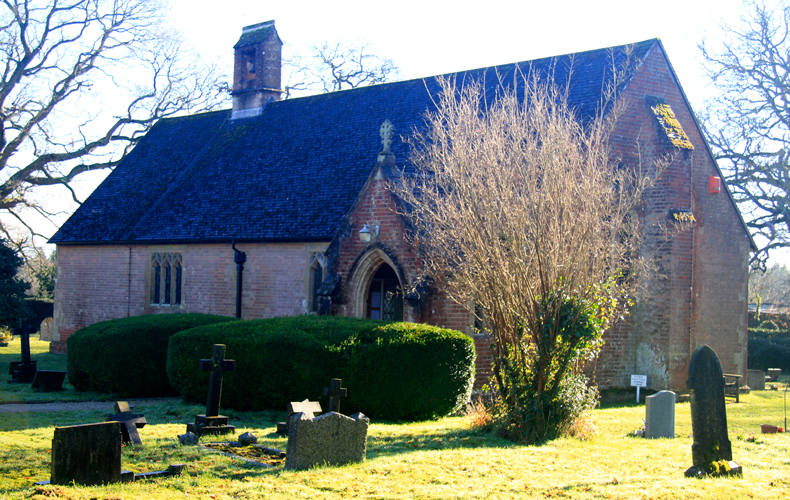
The Church of the
Ascension, Woodlands, is the only church with this title in the Diocese
of Salisbury. It bears witness to
the Lord Jesus Christ, risen, ascended and glorified, and yet is a
simple, brick built structure with a rather plain exterior, standing as
a reminder that he who was exalted to the highest heaven is he who came
down to earth from heaven (Ephesians 4.9-10) and was born
"in a lowly cattle shed." The architect was G. F. Bodley R.A.
He designed great cathedrals in Tasmania and Washington, but knew what
was fitting for the little village of Woodlands.
The Church was given by Harriet, Countess of
Shaftesbury, in memory of her husband, Anthony, the 8th Earl,
and was dedicated in 1892. Separating from Horton, the new parish was
endowed in 1926, and the church consecrated on June 16th , 1929.
Woodlands was part of the Shaftesbury estate until after the Second
World War. Most of the inhabitants were employed by the Earl or his
tenant farmers.
Though plain and humble, this Church of the Ascension
has been well-loved and cared for over the years. It offers spiritual
peace and a welcome to all who enter. This little church is full of all
kinds of interesting things and this text highlights some of them.
A
tour around the church
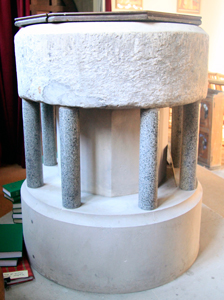 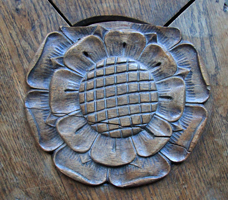 The first thing you see on entering is the
Font. Here
the sacrament of Baptism is celebrated, marking our "coming
in" to the church, that is, becoming members of Christ, children of
God, and inheritors of the kingdom of heaven – hence its position, a
reminder to those who have been baptised, and an invitation to those who
have not. (The picture -above left - shows the
top of the font cover.) The first thing you see on entering is the
Font. Here
the sacrament of Baptism is celebrated, marking our "coming
in" to the church, that is, becoming members of Christ, children of
God, and inheritors of the kingdom of heaven – hence its position, a
reminder to those who have been baptised, and an invitation to those who
have not. (The picture -above left - shows the
top of the font cover.)
The massive, rugged bowl is of Saxon/Norman origin, and
is set on a later base. Tradition has it that it had been in Knowlton
Church (now a ruin within the earthworks about two miles west of
Woodlands) and was said to have been used by Saint Aldhelm, the first
Bishop of Sherborne (d.709) It was found being used as a stepping stone
in a brook at Horton -rather appropriate, given that Baptism marks that
first step on the Christian's life of pilgrimage, the crossing over from
death to life. When the 7 th Earl of Shaftesbury was told
this story in 1842 he
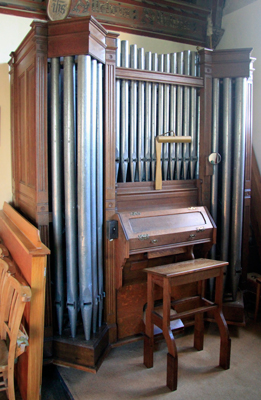 wrote
"If I or my family are ever rich
enough to build a church at Woodlands, this stone should be repaired and
restored to its holy and original purpose." It once had a tall,
ornate conical cover, designed by Sir Gilbert Scott and was cordoned off
when not in use, to emphasis its sacred function. wrote
"If I or my family are ever rich
enough to build a church at Woodlands, this stone should be repaired and
restored to its holy and original purpose." It once had a tall,
ornate conical cover, designed by Sir Gilbert Scott and was cordoned off
when not in use, to emphasis its sacred function.
At first the community was served by "priests in
charge" as the board behind the font indicates. They only became
"Vicar" when the parish was formed. Before the church was
built services were held in the school. You can see the "chariot of
fire", a symbol of ascension into heaven.
The worship offered here may be spoken or silent –
when sung it is supported by
the organ It was given in the 1990s
and came from the redundant Methodist chapel in Martin, just over the
border in Hampshire.
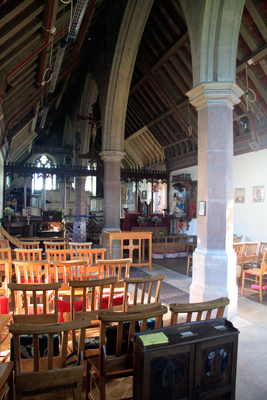 Three central columns
form arcading down the middle
of the nave; as far as is known the only other church built thus is a 14th
century church in Hannington, Northants. Many of the hassocks (kneelers)
in this part of the church have been lovingly worked and given in memory
of loved ones. On the Nave Altar is inscribed the Chi-Rho
monogram, formed by the first two Greek letters of "Christ".
Again we see the chariot of fire symbol. A modern cross was given by the
youth of the village in memory of Beverley Read in 1980. Three central columns
form arcading down the middle
of the nave; as far as is known the only other church built thus is a 14th
century church in Hannington, Northants. Many of the hassocks (kneelers)
in this part of the church have been lovingly worked and given in memory
of loved ones. On the Nave Altar is inscribed the Chi-Rho
monogram, formed by the first two Greek letters of "Christ".
Again we see the chariot of fire symbol. A modern cross was given by the
youth of the village in memory of Beverley Read in 1980.
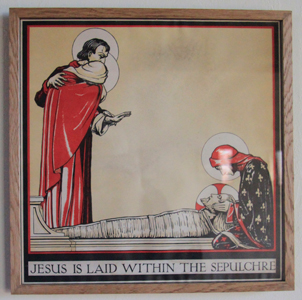 On the walls the
Stations of the Cross tell the
story of the suffering of the Lord, from his condemnation to his burial.
They are the focus of the traditional devotional service held here on
Fridays during the season of Lent, in preparation for Easter. They were
given in memory of Albert Edward Barker. The scripture texts in
Latin along the roof beams celebrate the triumph of the Lord, risen from
death and gloriously ascended into heaven – translated they read,
along the south side: "O magnify the Lord our God and fall down
before his footstool, for he is holy”, (Psalm 99.5); along
the north side: “They shall give thanks unto thy name, which is great,
wonderful, and holy” (Psalm 99.3)
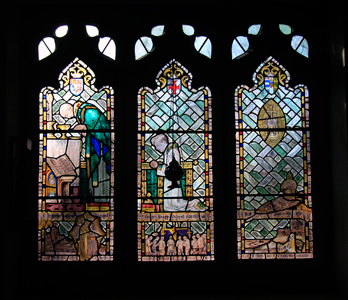 The South Nave Window (by Faith Craft Studio) was
donated in memory of Noel Knapp and shows St. Paul's and Lincoln
Cathedrals, the arms of Hurstpeirpoint College, the insignia of the
Guild of the Servants of the Sanctuary, Durham University and Lincoln
Theological College. The main window represents the celebration of Mass
— the celebrant and server being Fr. Knapp and Noel his son. Charles
Frederick Cooper Knapp ministered in this place from 1897 to 1945. Noel
was to have been ordained priest, but sadly was killed in a road
accident. Beneath the main window are shown men of the village keeping
vigil around the bier. The South Nave Window (by Faith Craft Studio) was
donated in memory of Noel Knapp and shows St. Paul's and Lincoln
Cathedrals, the arms of Hurstpeirpoint College, the insignia of the
Guild of the Servants of the Sanctuary, Durham University and Lincoln
Theological College. The main window represents the celebration of Mass
— the celebrant and server being Fr. Knapp and Noel his son. Charles
Frederick Cooper Knapp ministered in this place from 1897 to 1945. Noel
was to have been ordained priest, but sadly was killed in a road
accident. Beneath the main window are shown men of the village keeping
vigil around the bier.
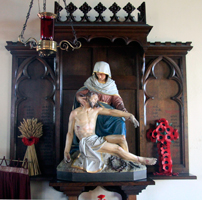 The Parish Memorial is a large "pieta",
the Blessed Virgin mourning her crucified Son, with the names of the
fallen inscribed on the oak panelling. The credence table beneath was
given by Elfreda Reuter in memory of her sister, Beatrice. The Parish Memorial is a large "pieta",
the Blessed Virgin mourning her crucified Son, with the names of the
fallen inscribed on the oak panelling. The credence table beneath was
given by Elfreda Reuter in memory of her sister, Beatrice.
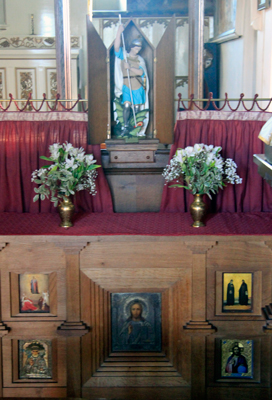 The Saint George's Altar was given by the S.Y.A.
(Seven Years Association) and was made locally. Five Russian Orthodox
icons have been incorporated in the altar front and on it stands an
unusual and remarkable Crucifixion group. These items were procured by
Fr. Knapp after the First World War, where they had been used by priests
ministering on the Russian Front. St. George is Patron Saint of Russia
as well as England. The Saint George's Altar was given by the S.Y.A.
(Seven Years Association) and was made locally. Five Russian Orthodox
icons have been incorporated in the altar front and on it stands an
unusual and remarkable Crucifixion group. These items were procured by
Fr. Knapp after the First World War, where they had been used by priests
ministering on the Russian Front. St. George is Patron Saint of Russia
as well as England.
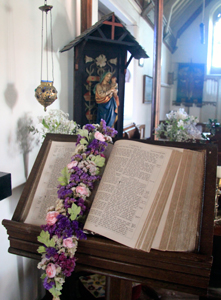 Our Lady's Shrine Our Lady's Shrine
was the
gift of the local Mother's Union. The carving was the work of Fr. Knapp.
The two brass vases on this altar were part of the gift donated in
memory of Beverley Read. The fine oak prayer bench was given in memory
of Lt. Col. Dendy. Many people have given chairs in memory of loved
ones, including the handsome oak seat commemorating Bert Thorne,
churchwarden for many years and a native of Woodlands.
The
Rood Screen ("rood" is an old word
for the Cross) symbolises man's alienation from God, but also the access
won for us by Jesus. The way to God is now open. Passing through, notice
the unusual choir stalls, made by Anthony Cutler, with curious carvings
by F. Gilliat.
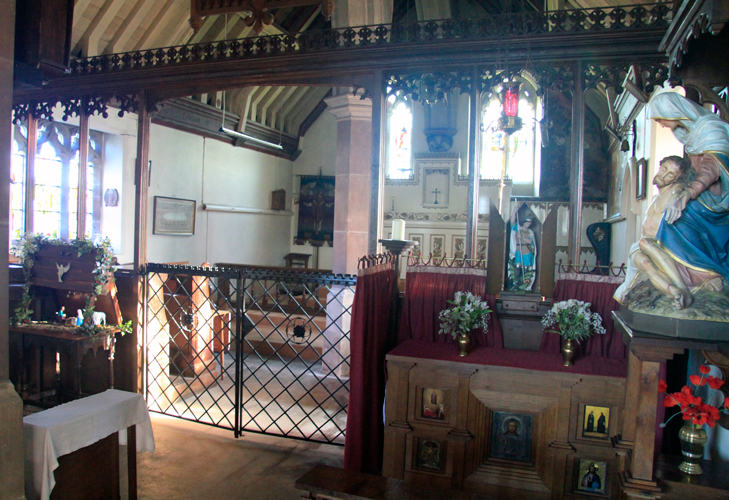
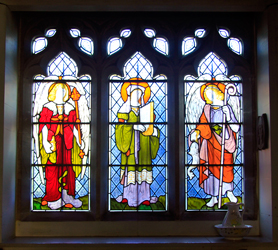 The
South Choir Window (by the Faith Craft
Studio) shows Eddi, the priest of Wilfred (in Kipling's poem in
"Rewards and Fairies") and St. Isidore, patron Saint of farm
workers. (pictured right) The
South Choir Window (by the Faith Craft
Studio) shows Eddi, the priest of Wilfred (in Kipling's poem in
"Rewards and Fairies") and St. Isidore, patron Saint of farm
workers. (pictured right)
The North Choir Window (by Beyaert of Bruges) shows the
archangels Gabriel (who appears in the Book of Daniel and in St. Luke's
Gospel) and Raphael (mentioned in the Books of Tobit and Enoch, and
associated with the ministry of healing). Between them is St. Cecilia,
the early Christian martyr and patron saint of musicians.
The Altar Rails are in memory of Hubert Edmund Thorne
who was killed on 20th of December 1954 while serving with
the R.A.F. The Sanctus Bell, traditionally rung at the Prayer of
Consecration at Holy Communion, was also given in his memory by his
mother. The Sanctuary Lamp was given to commemorate the Coronation of
Queen Elizabeth II.
This
Sanctuary is the heart of
the church. At the Altar is celebrated that Holy Sacrament which is known by a variety of
names in Christian tradition, Mass, Holy Communion, Eucharist, the
Lord's Supper, the divine Liturgy. Each of these brings out a particular
meaning of the rite which Jesus instituted on the night he was betrayed,
which we call Maundy Thursday. It is “an outward and visible sign of
an inward and spiritual grace”, at once a showing forth of his death
on Good Friday, a proclamation of his Resurrection at Easter, and a
pledge and anticipation of Kingdom come, likened by our Lord to a joyful
wedding reception.
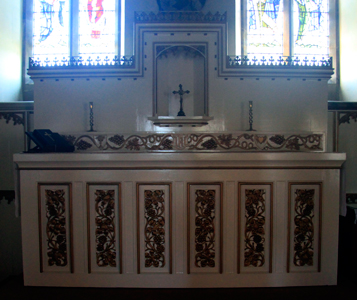 The
High Altar is at the East end of the church,
where the sun rises, for we celebrate the Rising of the Son. The gilded
carving reminds us of the saying of Jesus, "I am the true Vine,
and you are the branches" (St. John 15) United with him we
live, flourish and bear fruit; cut off from him we shrivel and die. The
windows (by Burlisson and Grylls) celebrate our fellowship with some
local saints through whom the Light shone. From left to right we see
St.Wulfhilda, who founded the Priory at Horton; St Osmund, Bishop of
Salisbury (d.1099); St. Aldhelm, first Bishop of Sherborne (d.709); St.
Birinus (d. 650), called the "apostle of Wessex" in
recognition of his work in spreading the Gospel.
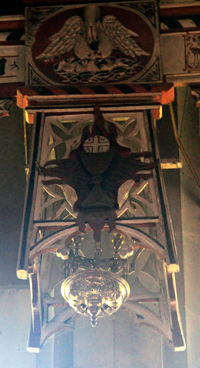 Above the Altar is a carving of the Angel of the Lord
bearing the tetragrammaton, the four-letter Hebrew name of God,
represented in English by YHWH. This name was held so sacred that it was
not spoken – coming across it written in the Bible the reader would
instead say "the LORD". Over the Altar is a rare
hanging
pyx, where the consecrated bread and wine are reserved, a sign of
the Lord's presence and available to be taken to the sick and housebound
as required. The inscription refers to Holy Communion as food for the
pilgrim and bread for the God's children. It's possible to see the pelican – said to
nourish its young on its own blood, it is an ancient symbol of Jesus
giving his life for us. Above the Altar is a carving of the Angel of the Lord
bearing the tetragrammaton, the four-letter Hebrew name of God,
represented in English by YHWH. This name was held so sacred that it was
not spoken – coming across it written in the Bible the reader would
instead say "the LORD". Over the Altar is a rare
hanging
pyx, where the consecrated bread and wine are reserved, a sign of
the Lord's presence and available to be taken to the sick and housebound
as required. The inscription refers to Holy Communion as food for the
pilgrim and bread for the God's children. It's possible to see the pelican – said to
nourish its young on its own blood, it is an ancient symbol of Jesus
giving his life for us.
 On the South chancel wall is shown his conception of how
we might share in the Resurrection at the Last Day. The Latin text on
the south side is from Psalm 47: "God is gone up with a merry
noise, and the Lord with the sound of the trump." The north
side has St. Paul quoting Psalm 68: "When Christ ascended up on
high he led captivity captive." The message carved
in the Nave Altar reads: "Go forth in Peace." On the South chancel wall is shown his conception of how
we might share in the Resurrection at the Last Day. The Latin text on
the south side is from Psalm 47: "God is gone up with a merry
noise, and the Lord with the sound of the trump." The north
side has St. Paul quoting Psalm 68: "When Christ ascended up on
high he led captivity captive." The message carved
in the Nave Altar reads: "Go forth in Peace."
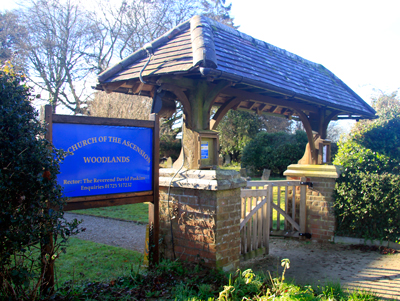 If
you pass through the
churchyard, with gravestones and monuments, you leave via the
lych-gate (given by the villagers in memory of Fr. Knapp in 1952).
"Lych" is an old word for corpse, and here the coffin is
received prior to the funeral service. These things remind us of our
mortality, but we put our faith in Jesus, risen, ascended, glorified,
and affirm our faith in him "God so loved the world, that he
gave his only-begotten Son to the end that whosoever believeth in him
should not perish but have everlasting life." (St. John 3.16) If
you pass through the
churchyard, with gravestones and monuments, you leave via the
lych-gate (given by the villagers in memory of Fr. Knapp in 1952).
"Lych" is an old word for corpse, and here the coffin is
received prior to the funeral service. These things remind us of our
mortality, but we put our faith in Jesus, risen, ascended, glorified,
and affirm our faith in him "God so loved the world, that he
gave his only-begotten Son to the end that whosoever believeth in him
should not perish but have everlasting life." (St. John 3.16)
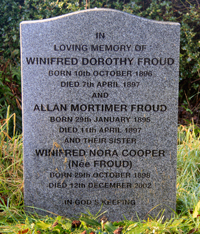 In
the Churchyard can be found an interesting Memorial to two very young
children, Winifred Dorothy Froud and Allan Mortimer Froud who died
within 10 days of each other after a Horse and Carriage accident at
Remedy Gate in 1897. In contrast their sister lived until 2002 when she
died aged 104.
Rev.
D. J. Paskins, Rector. |